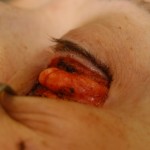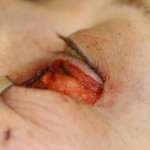
Anatomically, our eyeball is surrounded by cushions of fat so that it can be pushed around without breaking. This fat is held in place inside the eye socket by certain types of tissue that keep in back behind the rims of the eye socket. On the lower eyelid, a wall or partition between the lashline and the lower edge of the eye socket keeps fat back under the eye. With age, this tissue or ligament gets weak and the fat moves forward and bulges out. Simplistically, this represents a hernia of the lower eyelid. The bulge or bags you see on the lower eyelid is usually herniated fat.
The traditional lower blepharoplasty or eyelid tuck deals with this protruding fat as part of the operation. Removing or cutting it out is a mainstay of this eyelid rejuvenation procedure. This is a good approach for many patients but not for all. Removing too much fat or taking fat in someone with a tendency towards a more skeletonized face can create a sunken in look later, which is not ideally helpful in making a more youthful and attractive appearance.

Having performed both approaches to the lower eyelid bag repair, I find both of them effective. Sometimes the quality of the lower eyelid membrane is not very good, so I will simply do removal of the protruding fat. But when it is good, I prefer the hernia repair approach as it always seems better to preserve tissue as one ages.
An unanswered question about lower eyelid hernia repair is how it holds up long-term. Does the fat end up coming out again years later…or does the hernia repair hold up for a long time? This answer will become clearer in the next decade as many more of these are done and followed.
Dr. Barry Eppley
Indianapolis, Indiana


